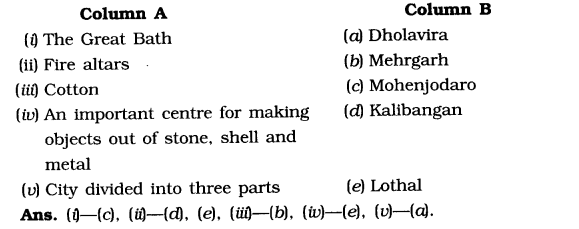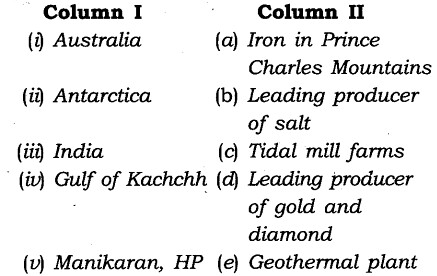EVENTS CONVENT HIGH SCHOOL
14/10/2021 CLASS-6 SESSION 2021-22
SUBJECT :SOCIAL SCIENCE HISTORY
chapter - 4
IN THE EARLIEST CITIES
______________________________________
I. Multiple Choice Questions
Choose the correct option to complete the statements given below:
(i) The Great Bath has been discovered in ……………….
(a) Lothal
(b) Harappa
(c) Mohenjodaro
(d) Kalibangan.
(ii) Most cities had the western part ………… and …………..
(a) smaller, higher
(b) smaller, lower
(c) larger, higher
(d) larger, lower.
(iii) Which of these groups of people did not usually live in cities, but the countryside?
(a) rulers
(b) craftspersons
(c) farmers and herders
(d) scribes
(iv) The alloy of tin and …………. is called bronze.
(a) zinc
(b) copper
(c) gold
(d) platinum.
(v) The city of Lothal was situated beside a river which was a tributary of
(a) Ganga
(b) Sabarmati
(c) Narmada
(d) Kaveri.
(vi) What caused the end of Harappan civilization?
(a) Deforestation
(b) Rulers lost control
(c) Flooding
(d) Reasons unknown to us; but probably those listed in the other three options.
Answer:
(i) – (c), (ii) – (a), (iii) – (c), (iv) – (b), (v) – (b), (vi) – (d).
II. Fill in the Blanks
Fill in the blanks with appropriate words to complete each sentence:
- The western part of Harappan cities, which was usually smaller but higher, has been referred to as the ……………..
- The eastern part of Harappan cities, which was usually larger but lower, has been referred to as the ……………
- The Great Bath was made water tight with a layer of………………….
- Scribes were people who knew how to ………………
- Metals like gold and silver were used to make …………… and ………….
Answer:
- Citadel
- lower town
- natural tar
- write
- ornaments, vessels
III. True/False
State whether these sentences are true (T) or false (F).
- The bricks in Harappa were laid in an interlocking pattern and that made the walls strong.
- Usually, the special buildings were created in the lower town.
- The houses of Harappa were poorly built.
- Harappan seals were made of metal
- People knew about cotton much before Harappa.
Answer:
- T
- F
- F
- F
- T.
IV. Matching Skill
Match the items in column A correctly with those given in column B.
V. Very Short Answer Type Questions
1. When and how was the site of Harappa first encountered? [Imp.]
Answer: Around a hundred and fifty years ago, when railway lines were being laid in Punjab, engineers stumbled upon the site of Harappa.
2. How old are Harappa cities believed to be?
Answer: Harappa and other such cities are believed to have developed 4700 years ago.
3. What was the citadel?
Answer: The western part of most cities was smaller but higher, described as ‘citadel’ by archaeologists.
4. Give some important features of the Great Bath. [V. Imp.]
Answer: The Great Bath was lined with bricks, Coated with plaster, and made water tight with natural tar.
5. Name two cities which had fire altars.
Answer: Lothal and Kalibangan were cities with fire altars.
V.Short Answer Type Questions
1. Describe the two parts of a typical Harappan city. [V. Imp.]
Answer: A Harappan city was usually divided into two or more parts. The part to the west was smaller but higher. It is called ‘citadel’. The part to the east was larger but-lower. Archaeologists call it the lower town.
2. How were bricks laid in houses of Harappan cities?
Answer: Bricks were so well made that they have lasted for thousand of years. They were laid in an interlocking pattern and this made the walls strong. Many of these bricks were taken away by engineers about a hundred and fifty years ago.
3. Describe the drains of the cities. [V. Imp.]
Answer: Most cities had covered drains. They were laid out carefully in straight lines. Each drain had a gentle slope. Thus, water could flow easily through it. Drains in houses were connected to those on the streets and smaller drains led to bigger ones.
4. Write a short note on the craft practised by Harappan.
Answer: Harappan objects were made of stone, shell and metal. Copper and bronze were used to make tools, weapons, ornaments and vessels. Gold and silver were used to make ornaments and vessels. Harappans also made stone seals. They made pots with beautiful black designs.
5. Where did the Harappan get the raw materials from?
Answer: The Harappans got the raw materials from various places. They got copper probably from present-day Rajasthan, and also from Oman. Tin was brought from Afghanistan and Iran. Gold was brought may be from Karnataka. Precious stones were brought from Gujarat, Iran and Afghanistan.
6. Why were metals, writing, the wheel and the plough important for the Harappans?
Answer:
- Metals: The Harappan made copper tools. They also made ornaments of gold and silver.
- Writing: Writing was very important for the Harappans. There were scribes, people who knew how to write. Scribes helped prepare the seals and perhaps wrote on other materials that have not survived.
- Wheel: The Harappans used the wheel in carts. They also used the wheel in spinning. The wheel was used by potters to make or shape pots and other things.
- Plough: Plough was used to prepare the land for farming by the Harappans.






